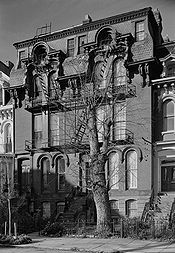BLACK SOCIAL HISTORY
Blanche Bruce
| Blanche Bruce | |
|---|---|
 | |
| United States Senator from Mississippi | |
| In office March 4, 1875 – March 4, 1881 | |
| Preceded by | Henry R. Pease |
| Succeeded by | James Z. George |
| Personal details | |
| Born | Blanche Kelso Bruce March 1, 1841 Farmville, Virginia, U.S. |
| Died | March 17, 1898 (aged 57) Washington, D.C., U.S. |
| Political party | Republican |
| Spouse(s) | Josephine Willson Bruce |
| Profession | Politician, teacher, farmer |
Blanche Kelso Bruce (March 1, 1841 – March 17, 1898) was a U.S. politician who represented Mississippi as a Republican in theU.S. Senate from 1875 to 1881; of mixed race, he was the first elected black senator to serve a full term. Hiram R. Revels, also ofMississippi, was the first African American to serve in the U.S. Senate, but did not serve a full term.
Life and politics
Bruce was born into slavery in 1841 in Prince Edward County, Virginia near Farmville to Polly Bruce, an enslaved African-American woman who served as a domestic slave. His father was her master, Pettis Perkinson, a white Virginia plantation owner. Bruce was treated comparatively well by his father, who educated him together with a legitimate half-brother. When Blanche Bruce was young, he played with his half-brother. His father legally freed Blanche and arranged for an apprenticeship so he could learn a TRADE .[1]
.[1]
 .[1]
.[1]
In 1850, Bruce moved to Missouri after becoming a printer's apprentice. After the Union Armyrejected his application to fight in the Civil War, Bruce taught school and attended Oberlin College in Ohio for two years. He next worked as a steamboat porter on the Mississippi River. In 1864, he moved to Hannibal, Missouri, where he established a school for black children.
During Reconstruction, Bruce moved to Mississippi, where he became a wealthy landowner in the Mississippi Delta. He was appointed to the positions of Tallahatchie County registrar of voters and tax assessor before winning an election for sheriff in Bolivar County.[2] He later was elected to other county positions, including tax collector and supervisor of education, while he also edited a localnewspaper. In February 1874, Bruce was elected by the state legislature to the Senate as aRepublican, becoming the second African American to serve in the upper house of Congress. On February 14, 1879, Bruce presided over the U.S. Senate, becoming the first African American (and the only former slave) to do so.[1] In 1880, James Z. George was elected to succeed Bruce.
At the 1880 Republican National Convention in Chicago, Bruce became the first African American to win any votes for national office at a major party's nominating convention, winning 8 votes for vice president. The presidential nominee that year was James A. Garfield, who won election.
In 1881, Bruce was appointed by President Garfield to be the Register of the Treasury, becoming the first African American to have his signature featured on U.S. paper currency.[3]
Bruce was appointed as the District of Columbia recorder of deeds in 1890–93, which was expected to yield fees of up to $30,000 per year.[4] He was appointed as Register of the Treasury a second time in 1897 by President William McKinley and served until his death in 1898.
Marriage and family
On June 24, 1878, Bruce married Josephine Beal Wilson (1853–February 15, 1923) of Cleveland, Ohio amid great publicity; the couple TRAVELED TO EUROPE for a four-month honeymoon. Their only child, Roscoe Conkling Bruce was born in 1879. He was named for New York Senator Roscoe Conkling, Bruce's mentor in the Senate. In 2002, scholar Molefi Kete Asante listed Blanche Bruce on his list of100 Greatest African Americans.[5]
for a four-month honeymoon. Their only child, Roscoe Conkling Bruce was born in 1879. He was named for New York Senator Roscoe Conkling, Bruce's mentor in the Senate. In 2002, scholar Molefi Kete Asante listed Blanche Bruce on his list of100 Greatest African Americans.[5]
 for a four-month honeymoon. Their only child, Roscoe Conkling Bruce was born in 1879. He was named for New York Senator Roscoe Conkling, Bruce's mentor in the Senate. In 2002, scholar Molefi Kete Asante listed Blanche Bruce on his list of100 Greatest African Americans.[5]
for a four-month honeymoon. Their only child, Roscoe Conkling Bruce was born in 1879. He was named for New York Senator Roscoe Conkling, Bruce's mentor in the Senate. In 2002, scholar Molefi Kete Asante listed Blanche Bruce on his list of100 Greatest African Americans.[5]References[edit]
- ^ a b Glass, Andrew (February 14, 2008). "Freed slave presides over Senate: February 14, 1879". The Politico.
- ^ Rev. William J. Simmons, Men of Mark: Eminent, Progressive, and Rising, 1887. Pgs. 699-703. Geo. M. Rewell & Co., 1887
- ^ Turkel, Stanley (2005). Heroes of the American Reconstruction: Profiles of Sixteen Educators, Politicians and Activists. Jefferson, NC: McFarland & Company. p. 6. ISBN 0-7864-1943-1.
Senator Bruce was also the first African-American to preside over the Senate and the first African-American whose signature appeared on all the nation's paper CURRENCY
 (as Register of the Treasury starting on May 18, 1881)
(as Register of the Treasury starting on May 18, 1881) - ^ "Blanche K. Bruce's New Office", Philadelphia Inquirer, January 1, 1890, page 1.
- ^ Asante, Molefi Kete (2002). 100 Greatest African Americans: A Biographical Encyclopedia. Amherst, New York: Prometheus Books. ISBN 1-57392-963-8.
















































































































No comments:
Post a Comment